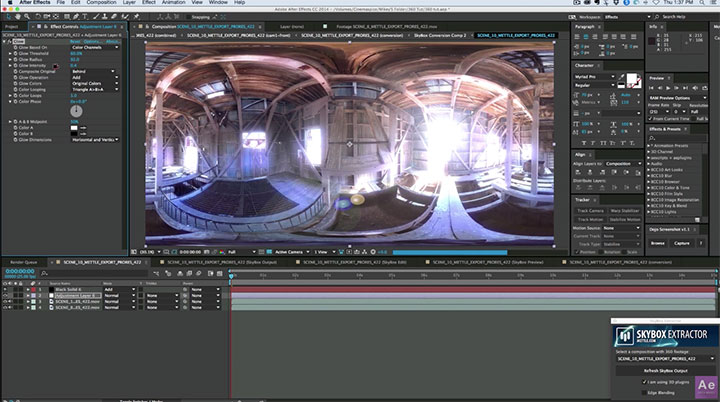Cover image via
- After Effects 360 Video
- Export 360 Video After Effects
- Convert 360 Video To 2d
- After Effects Export 360 Video
After Effects: Create 360 YouTube Videos & Environments with Mettle SkyBox Studio VinhSon Nguyen ( creativedojo.net ) shows how to create a 360 video within After Effects using SkyBox Studio. He does a great job of explaining the workflow from file setup to rendering the video and injecting the youtube metadata. What you learned: How to import After Effects scenes with 3D layers into 360 videos Launch the VR Comp Editor from the Window tab. Add a 3D Edit and leave the composition selection on. Under the Edit Properties options, select Import 3D Comp.
In this video tutorial, we explore how you can improve a 360° footage shot with a consumer-grade camera.

Now that 360° cameras have been out for a few years, there are many more consumer-grade options available. (Some popular models include the GoPro Fusion, Samsung Gear 360, Ricoh Theta V, Kodak Orbit 360.) Most consumer-grade 360° cameras cost a few hundred dollars, whereas professional models can start at a few thousand and increase drastically from there.
The quality of consumer models can be hit or miss, but most will at least output 4K 360° video. Visually, a professional 360° camera will almost always give you better results. However, professional-grade cameras can be a hassle on shoots, requiring lots of finesse. I’ve opted to use consumer 360° cameras on quite a few shoots, and in this tutorial, I want to share some tips that can help visually improve the quality of your 360° footage.
Bitrate
Most consumer-grade 360° cameras film 4K video at around 50-60 mbps. This is relatively low for 4K footage. (For example, think “mushy” tree leaves on drone footage, which is often 50 mbps.) There’s not much you can do to change the bitrate in the camera itself, but here are two tips I recommend: film while stationary and stitch the footage manually.


Filming stationary, on a tripod or monopod, will help preserve the detail of the surroundings during recording. Faster movement and quick scene changes will increase the chance for compression artifacts. Also, by stitching the 360 footage manually in a program like Autopano Video Pro or After Effects, you can control the export bitrate for your final video. This helps ensure that you don’t lose any additional detail.
360° Photos
Often, the 360° photo quality on consumer cameras will be far superior to the video quality. For example, the Samsung Gear 360 records 4K video, but it actually takes 8K 360° photos. You can use those photos to create a 360° video, overlaying information graphics, music, etc. This can be a great option for client videos and tour 360° videos, where movement isn’t a major factor. (And quite often it is worth the trade-off for the jump in image detail.)
VR Sharpen and VR Color Gradients
Adobe has integrated many VR effects for 360° video into Premiere Pro and After Effects. Two I highly recommend are the VR Sharpen and VR Color Gradients effects. You can use VR Sharpen to add a little more “bite” to your 360° video, if it’s lacking image detail. I recommend a value between 8-16.
Use the VR Color Gradients effect like color lens gels or filters for your 360° footage. You can easily customize the colors, blending modes, and opacity levels. This effect is great for adding a splash of color to flat footage.
Looking for more video tutorials? Check these out.
In this tutorial for envatotuts+, Charles Yeager shows how to create a 360° Video in After Effects using the plugin SkyBox Studio by Mettle. Everyone can follow along with this tutorial by downloading a free trial of SkyBox Studio plugin.

In the first part of this tutorial Charles sets up a basic 3D scene in After Effects, using the plugin Element 3D for this, but you can use any 3D plugin or just 3D layers in After Effects.
Charles explores the features of SkyBox Studio, so you can learn about how the plugin works. He animates a camera in the 3D scene of the animation.
Finally, you can learn the steps needed to upload the 360° Video to Youtube so you can watch the video in 360°.
After Effects 360 Video
How to Create 360° Videos in Adobe After Effects | hosted by Charles Yeager for envatotuts+
Set up your cityscape using Element 3D Metropolitan Pack, street_layout_4.
SkyBox Creator takes the Main comp and brings it into the precise format necessary for 360 output.
SkyBox Creator places 6 camera views, linked to a SkyBox Master Camera, to give a mathematically precise 360 output file.
Export 360 Video After Effects
Learn how to do a simple camera move through the cityscape, to make your 360 video more immersive.

See how to use SkyBox Converter to change formats easily between Equirectangular, Cubic Cross, Spherical and FullDome.
See how to render out your Main comp with the correct settings, and apply youtube metadata.
Charles Yeager.
Filmmaker & Motion Graphics Artist currently residing in Little Rock, and always exploring new opportunities in the production industry. His projects have been recognized by Canon, Tiffen, Video Copilot, RØDE, Vimeo, GSG, VideoMaker, Filmmaker IQ, No Film School, BOOM Library, Film Convert, Tuts+ & Filminute.
Find out more at yeagerfilm.com
Convert 360 Video To 2d
Mettle Skybox Suite has joined Adobe.
Mettle Skybox Suite of plugins will be exclusively available as part of your Creative Cloud membership through deep, native integration with Premiere Pro CC and After Effects CC. Adobe Creative Cloud will offer an end to end experience for crafting rich and compelling VR/360 experiences.
After Effects Export 360 Video
Learn more – Adobe and Mettle VR: 360 degrees better
